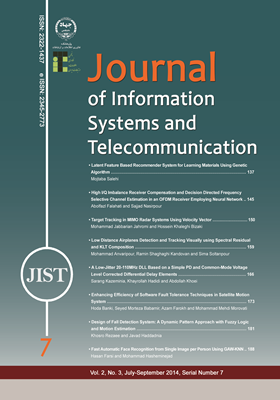Latent Feature Based Recommender System for Learning Materials Using Genetic Algorithm
محورهای موضوعی : Pervasive computing
1 - K. N. Toosi
کلید واژه: Collaborative Filtering, Hybrid Recommendation, E-Learning, Learning Materials, Sparsity Problem, , , ,
چکیده مقاله :
With the explosion of learning materials available on personal learning environments (PLEs) in the recent years, it is difficult for learners to discover the most appropriate materials according to keyword searching method. Recommender systems (RSs) that are used to support activity of learners in PLE can deliver suitable material to learners. This technology suffers from the cold-start and sparsity problems. On the other hand, in most researches, less attention has been paid to latent features of products. For improving the quality of recommendations and alleviating sparsity problem, this research proposes a latent feature based recommendation approach. Since usually there isn’t adequate information about the observed features of learner and material, latent features are introduced for addressing sparsity problem. First preference matrix (PM) is used to model the interests of learner based on latent features of learning materials in a multidimensional information model. Then, we use genetic algorithm (GA) as a supervised learning task whose fitness function is the mean absolute error (MAE) of the RS. GA optimizes latent features weight for each learner based on his/her historical rating. The method outperforms the previous algorithms on accuracy measures and can alleviate the sparsity problem. The main contributions are optimization of latent features weight using genetic algorithm and alleviating the sparsity problem to improve the quality of recommendation.
With the explosion of learning materials available on personal learning environments (PLEs) in the recent years, it is difficult for learners to discover the most appropriate materials according to keyword searching method. Recommender systems (RSs) that are used to support activity of learners in PLE can deliver suitable material to learners. This technology suffers from the cold-start and sparsity problems. On the other hand, in most researches, less attention has been paid to latent features of products. For improving the quality of recommendations and alleviating sparsity problem, this research proposes a latent feature based recommendation approach. Since usually there isn’t adequate information about the observed features of learner and material, latent features are introduced for addressing sparsity problem. First preference matrix (PM) is used to model the interests of learner based on latent features of learning materials in a multidimensional information model. Then, we use genetic algorithm (GA) as a supervised learning task whose fitness function is the mean absolute error (MAE) of the RS. GA optimizes latent features weight for each learner based on his/her historical rating. The method outperforms the previous algorithms on accuracy measures and can alleviate the sparsity problem. The main contributions are optimization of latent features weight using genetic algorithm and alleviating the sparsity problem to improve the quality of recommendation.


